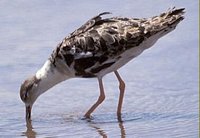Ruff
|
|
| Ruff | ||||||||||||||
|---|---|---|---|---|---|---|---|---|---|---|---|---|---|---|
 | ||||||||||||||
| Scientific classification | ||||||||||||||
| ||||||||||||||
| Binomial name | ||||||||||||||
| Philomachus pugnax (Linnaeus,, 1758) |
The Ruff (Philomachus pugnax) is a medium-sized wader.
Their breeding habitat is bogs, marshes and wet meadows with short vegetation in northern Europe and Russia. Ruff are migratory, wintering in southern and western Europe, Africa and India. They are highly gregarious, with a wintering flock of 1 million birds reported in Senegal.
This species is a rare migrant to North America, but has bred in Alaska, USA.
These birds nest in a well-hidden location on the ground, laying 3-4 eggs. The males display at a lek during the breeding season, standing erect, crouching or taking a variety of postures with the ruff erected. They may jump into the air. They are silent while displaying and when not breeding.
These birds forage in wet grassland and soft mud, probing or picking up food by sight. They mainly eat insects and earthworms.
These birds have a distinctive "gravy boat" appearance, with a small head and medium bill, longish neck and pot-bellied profile. Males are larger than females. They have longish usually yellowish legs, and show white ovals on the tail sides in flight.
Breeding males have black, chestnut or white neck ruffs. Their backs are grey-brown and the underparts white except for the black breast. Females are grey-brown above and white below. In winter, both sexes are a paler grey above and white below and can be differentiated only by size. Young birds are like winter birds, but buff below, and their upperparts have a more scaly appearance.
There exist two main types of males, which are fixed by a simple genetic polymorphism: resident and satellite males. These types can be distinguished by appearence and behaviour: Resident or independent males (84%) have intensely-colored ruffs (black or chestnut) and stake out and occupy mating territories in the lek. They actively court males and display a high degree of aggression towards other resident males, while tolerating satellite males to a high extent. Satellite males (16%) have light (white or mottled) ruffs and do not occupy own territories, but rather use those occupied by resident males and mate opportunistically with females that wander across the territory. There is generally little aggression by and towards satellite males.
Notably, while satellite males are on average noticeably smaller and lighter, nutricion of chicks does not influence mating strategy, but rather, the inherited mating strategy heavily influences body size: Resident-type chicks will, if provided with the same amount of food, grow heavier than satellite-type chicks. Therefore, the mating strategies constitute an environmentally stable simple polymorphism. The shift from the expected Mendelian frequencies of 75% vs. 25% is probably due to the smaller size of the independent males, which results in somewhat higher overall mortality.
Moreover, the genetic locus relevant for the mating strategy is located on an autosome. That means that both sexes carry 2 alleles, not only males (whereas mammal males have the gonosomes XY and females have XX, in birds it is the other way around, males having the gonosomes ZZ and females WZ. W, X, Y and Z are technical terms, with X- and Z-chromosomes or Y- and W-chromosomes being analogous in male- and female-determining heterogame systems, respectively). If ruff females (which are always non-territorial) are given testosterone implants, they display the male territorial behaviour according to their genotype.
A female ruff is called a reeve.
A ruff is also an extended stiff collar, like that of the bird, formerly worn as an item of clothing.
For the meaning in card games see ruff (cards), crossruff.
Literature:
- D B Lank, C M Smith, O Hanotte, T Burke & F Cooke: Genetic polymorphism for alternative mating behaviour in lekking male ruff Philomachus pugnax. Nature 378, p.59-62 (1995)

